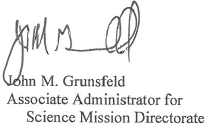| National Aeronautics and Space Administration Headquarters Washington, DC 20546–0001 |
 |
||
| Reply to Attn of: | Science Mission Directorate | OCT 03 2014 | |
| Dr. David N. Spergei Chair, Space Studies Board National Research Council 500 Fifth Street, NW Washington, DC 20001 |
Dear Dr. Spergei:
In accordance with international treaty obligations, NASA maintains a planetary protection policy to avoid biological contamination of other worlds, as well as to avoid the potential for harmful effects on the Earth due to the return of extraterrestrial materials by spaceflight missions. NASA Policy Directive 8020.7 requires that planetary protection requirements be based on recommendations from both internal and external advisory groups, but most notably the Space Studies Board (SSB). NASA relies on the Board’s ability to synthesize input from a wide spectrum of the science community and provide expert advice and recommendations, both as an advisory body and as the U.S. representative to the International Council for Science’s Committee on Space Research (COSPAR), which is consultative to the United Nations Committee on the Peaceful Uses of Outer Space. As such, the SSB’s recommendations on planetary protection are internationally recognized as authoritative and independent of NASA.
Planetary protection requirements for each mission and target body depend upon the type of encounter it will have (e.g., flyby, orbiter, or lander) and the nature of its destination (e.g., a planet, moon, comet, or asteroid). If the target body has the potential to provide clues about the origins and evolution of life or prebiotic chemical evolution, a spacecraft going there must meet a higher level of cleanliness, and some operating restrictions will be imposed. Spacecraft going to target bodies with the potential to support Earth life must undergo stringent cleaning and bioload- reduction processes, and may be subject to greater operating restrictions.
Current COSPAR planetary protection policy designates the categorization IVc for spacecraft potentially accessing a so-called Special Region on Mars, and imposes specific constraints on spacecraft development and operations. A Special Region is defined as a location on or within Mars where Earth life might survive and proliferate. Previous planetary protection studies have revealed that Earth life can reasonably be expected to proliferate if the temperature is above –25 C and the water activity is greater than 0.5 (relative humidity of 50%), simultaneously.
At NASA’s request, the community-based Mars Exploration Program Analysis Group (MEPAG) established the Special Regions Science Analysis Group (SR-SAG2) to examine tire quantitative definition of Special Regions and propose modifications to it, as necessary, based upon the latest scientific results. SR-SAG2 was also asked to conduct a preliminary analysis of specific environments that should be considered “special” and “non-special.”
As NASA develops its plans for the Mars 2020 mission and, in particular, finalizes the selection of candidate landing sites, it would be very helpful for the SSB to review the conclusions and recommendations contained in MEPAG’s SR-SAG2 report and assess their consistency with current understanding of both the martian environment and the physical and chemical limits for the survival and propagation of microbial and other life on Earth.
As you know, the European Space Agency (ESA) also has ambitious plans for future Mars exploration missions. It is our understanding that ESA has requested the European Science Foundation (ESF) conduct a very similar review of MEPAG’s SR-SAG2 report. Given the close working relationship between NASA and ESA, in general, and their respective Planetary Protection Offices, in particular, the NRC should engage with ESF and explore the possibility of a joint study responsive to the needs of both agencies. Jt is expected that a detailed scope and objectives Terms of Reference for such ajoint undertaking will be established by consultation between the NRC and the ESF.
I would like to request that the NRC submit a plan for establishment of an ad hoc committee to review the current planetary protection requirements for Mars Special Regions and their proposed revision as outlined in the 2014 Special Regions report of the Mars Exploration Program Analysis Group (MEPAG SR-SAG2). The resulting report from the review should include recommendations for an update of the planetary protection requirements for Mars Special Regions. The results of the assessment will be most useful to NASA if it is received no later than the summer of 2015. The task performance period itself should extend to November 30, 2015, to cover printing and distribution of the final report.
Once agreement on the scope, cost, and schedule for the proposed study has been achieved, the Contracting Officer will issue a task order for implementation. Dr. Catharine A. Conley, Planetary Protection Officer, will be the technical point of contact for this effort and may be reached at cassie.conley@nasa.gov or (202) 358-3912.
Sincerely;

cc: Science Mission Directorate/Dr. M. Allen
• Dr. C. Conley
• Ms. D. Holland
• Dr. B. Pugel



